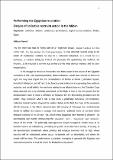Performing the Egyptian revolution : origins of collective restraint action in the Midan
Abstract
In January/February 2011, the world watched with admiration the Egyptian revolution that toppled President Housni Mubarak. The demonstration in Midan al-Tahrir (Liberation Square in central Cairo), which was the nucleus of the revolution, highlighted a largely spontaneous, civil and peaceful political performance. However, this performance was temporary, contradicting subsequent bloody conflicts in post-revolutionary Egypt. This article examines the socio-political origins of the Midan performance. It argues that the demonstrators exercised collective restraint, which was temporary but necessary, in order to topple Mubarak. Building on Norbert Elias’ civilising process theory and social movements literature, it is argued that the origins of this performance are found in a collective knowledge of regime strategy and narrative, Egyptian socio-political values and existing repertoires of contention. Drawing on primary sources and semi-structured interviews, the article contends that the demonstrators exercised collective restraint to reframe regime narrative and draw public support for the revolution.
Citation
Saouli , A 2015 , ' Performing the Egyptian revolution : origins of collective restraint action in the Midan ' , Political Studies , vol. 63 , no. 4 , pp. 730-746 . https://doi.org/10.1111/1467-9248.12135
Publication
Political Studies
Status
Peer reviewed
ISSN
0032-3217Type
Journal article
Description
This research was supported by a Carnegie Trust for the Universities of Scotland grant.Collections
Items in the St Andrews Research Repository are protected by copyright, with all rights reserved, unless otherwise indicated.

